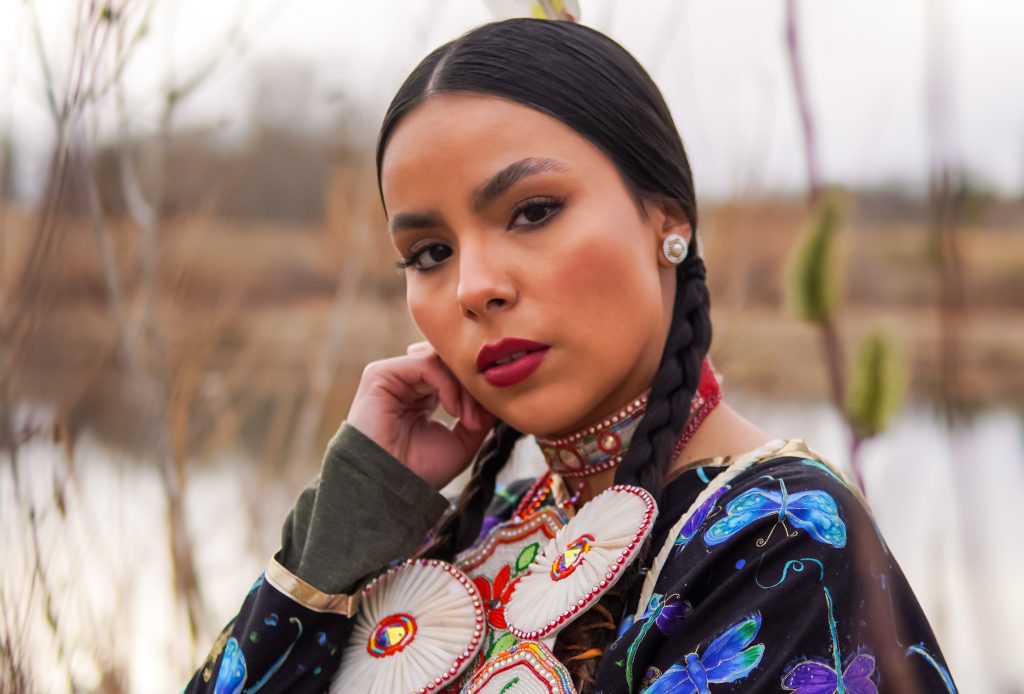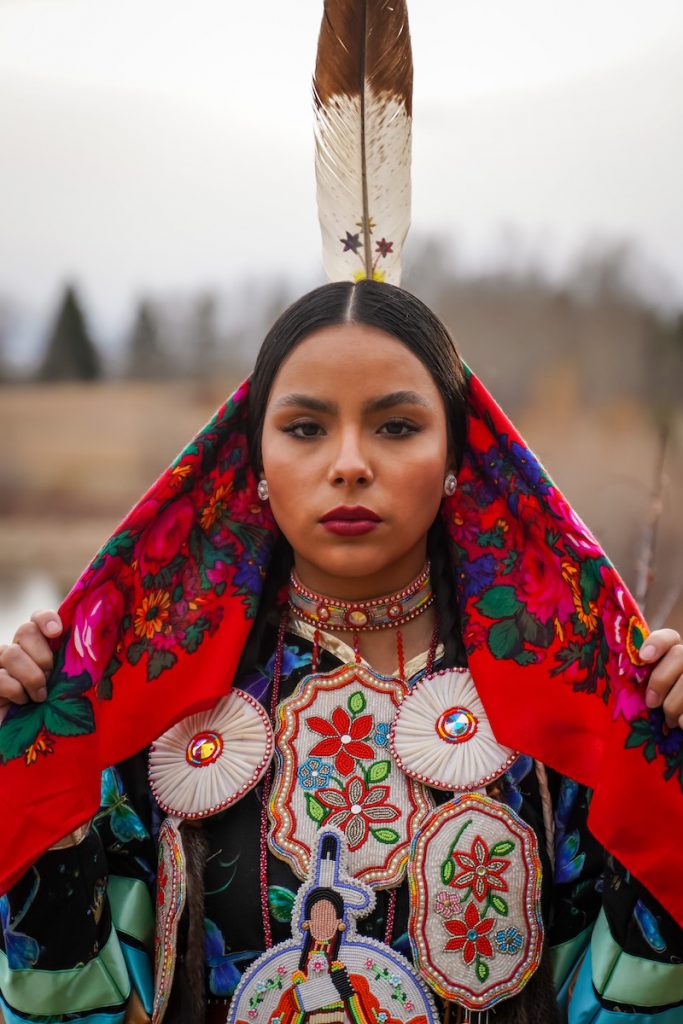
If you don’t already know Nikita Kahpeaysewat, this is your chance to learn more about this multi-talented woman who’s taking the world by storm in more ways that we can keep up with! We caught up with Nikita for a one-on-on to find out how she’s combined an impressive range of personal passion and inspiration to carve out a unique—and successful—career for herself.
Style Nine to Five: Hello! Thanks for talking with us! Let’s start with how you came to pursue such a diverse career, as a model, Indigenous influencer, makeup artist, activist….and more! Did you set out to establish your career this way or was it a natural evolution for you?
Nikita Kahpeaysewat: I originally started my page with hopes of becoming an established makeup artist however, that quickly changed when I began to post photos of myself in my pow-wow regalia. I noticed people, Indigenous and non-Indigenous folks, were more interested in that part of my life and wanted to learn more about it. So, I started to incorporate makeup and Indigenous culture into my page, I made YouTube videos, I made makeup tutorials, and I found this happy middle ground.
My content changes seasonally, as do I. As I have gotten deeper into my environmental science degree, so has my environmental activism.
My online presence has been a timeline of self-discovery. As far as modelling, I have been doing that as a side hobby since I was 14-years-old. When I was 19, I tried to take it more seriously however, I was turned down by a lot of agencies because I didn’t fit into their tiny Eurocentric box of what beauty is.
I took it upon myself to create my own photoshoots. I became a photographer, MUA, hair stylist, stylist, editor, for all my photos. I did this for a couple of years and have grown to like the freedom of being a freelance model. It wasn’t until 2020, when I was “discovered” online and began to collaborate with local photographers on Indigenous-theme photos.
SNTF: What’s the most challenging part of pursuing so many roles? What’s the most rewarding part?
NK: The challenging part of pursuing so many roles is that I want to excel in all things I do however, I cannot commit 100% to everything. So, some months I do great in school and research, other months my social media is popping, and the cycle continues.
The most rewarding part is the interactions and relationships I develop with my audience. Oftentimes, many Indigenous folks who didn’t have a connection to their culture reach out to me and tell me I inspired them to reconnect with that part of themselves. To know that what I do and what I say has a positive impact on our people is the most rewarding part of my work.

SNTF: What is the value of having multiple career paths vs. one set job?
NK: I have never been a fan of pursuing one career and sticking to it. I like the opportunity to express myself in many different ways. I need a creative outlet = modelling, I need a curiosity outlet = research, I need to contribute to society = environmental work, I need to connect with my culture = ceremonies and mentors, and I need to connect with others = social media.
SNTF: How do you balance your right brain (creativity, fashion, dance, etc.) with your left brain work as an Environmental Science student? Do you think that people need a combination of both sides for personal and professional success?
NK: I have been trying to create “balance” in my life for so long that I feel it is inevitable. Instead, I opt for “what does my spirit need at this moment?” There will be times when I can only focus on environmental related work and research and there will be times when I need to be creative. It is less about planning content and more about where I am in the moment. I have found this works so much better for me as I used to plan my shoots and feel unsettled when the day came and I couldn’t deliver. Go with the flow.
SNTF: How did you become such a passionate and esteemed advocate for Indigenous voices? Was activism a natural part of your life or was it something you consciously set out to do?
NK: I went to high school in a predominantly white community, where I often found myself to be the only POC. I looked around the room and realized that white communities do not have frequent boiled-water advisories. They have access to dental, health care, job opportunities, post-secondary opportunities, and generational wealth. I wondered why Indigenous folks were put at a disadvantage to obtain those things. I became asking questions, doing research and taking Indigenous-related classes.
My parents would tell me stories of how society treated them growing up. I remember my father telling me about a time when he was in university and a professor would constantly fail him simply because he was Indigenous. Or how they wouldn’t be able to obtain careers in predominantly white industries. Or the time when racist white folks would start trouble and it would be us in the blame and us who paid the consequences. I realized that their experience was now mine. As I dig deeper, I noticed that when it comes to the environment, Indigenous people are the first to be affected by climate change but the last to be consulted and helped.
SNTF: One of your goals is to educate people on the beauty of Indigenous culture and the concept of combining Indigenous ways of knowing with western science – why is it important for people to embrace and understand other cultures and ways of thinking?
NK: Indigenous knowledge is sustainable knowledge. Indigenous knowledge is scientific knowledge. They are the same but stem from two completely different worlds. Scientists today are realizing that Indigenous knowledge is the future to a greener industry. Our practices have always been timeless. There are strengths in Western science and Indigenous knowledge, I believe that in order to create a sustainable future, we must include Indigenous folks into the green movement. As the first people to this land, we have a deeper knowledge system of how to care for it.
SNTF: What advice do you have for people who want to turn their personal passions into a career and how to get started?
NK: Be authentic. Be brave. Take the time to understand what it is that truly drives you in this lifetime.
By: Jeanine Gordon – Jeanine is a freelance writer and editor with a passion for creating stellar
content for global brands and small businesses alike – specializing in fashion and lifestyle.
Photos of Nikita Kahpeaysewat by Devin Featherstone, @feather.photo.
